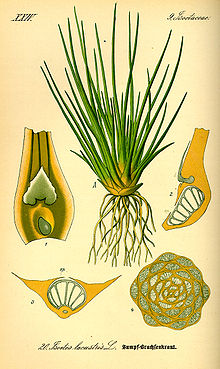Lake bream
| Lake bream | ||||||||||||
|---|---|---|---|---|---|---|---|---|---|---|---|---|

Sea bream ( Isoetes lacustris ) |
||||||||||||
| Systematics | ||||||||||||
|
||||||||||||
| Scientific name | ||||||||||||
| Isoetes lacustris | ||||||||||||
| L. |
The sea bream ( Isoetes lacustris ) is a species of the bream herb ( Isoetes ), a systematically isolated group of the order of the club moss plants (Lycopodiopsida). This aquatic plant is common in Europe and North America.
description

(1) Leaf base with sporangium at the base and ligule above - (2) Longitudinal section and (3) Cross section of the leaf base with the chambered sporangium - (4) Cross section through the base of the shoot
The sea bream is a perennial plant that reaches heights of 3 to 15 centimeters. It has an unbranched, compressed, bulbous stem axis that shows secondary growth in thickness . On the stem axis there is a rosette of up to 70 bulrush-shaped leaves . The dark green, stiff leaves are flat and rutted at the base, with a rounded stalk above, 5 to 20 (up to 40) cm long and 2 to 3 mm wide and short-pointed. The ligula is hardly longer than it is wide.
The sporangia stand in a pit at the base of the sheathed enlarged leaves, which is covered in the upper third by a veil (velum). The macro and micro sporophylls are designed in the same way, the former standing on the outside of the rosette, the latter on the inside. The whitish macrospores have a densely wrinkled surface and a diameter of 530 to 700 µm. The light brownish microspores measure around 40 × 30 µm and usually have a low, sometimes ridge-like elongated warty, rarely smooth surface. The spores ripen from July to September.
The prothallium is unisexual, short-lived and remains in the spore. The spermatozoids are multi-flagellated .
The sea bream is decaploid with a chromosome number of 2n = 110.
ecology
The spore ripening of the sea bream takes place in late summer and early autumn, germination and embryo formation were hardly known.
Old leaves peel off in autumn and then wash up on the banks of the lake. Here one suspects the prothalium development and fertilization. Detached leaves (which contain macro- and microsporangia) can also be carried to other bodies of water by birds.
Occurrence
The sea bream is common in Europe, North America and Japan. In Europe, the sea bream is found in Western, Northern and Eastern Europe , and is rare in Central Europe . In Europe it is found mainly in Northern Europe, Great Britain , Ireland , Iceland , the Scandinavian countries, Finland , in the bordering parts of Russia , and in Denmark . Occasionally it also occurs in Spain , the Pyrenees and the French Massif Central .
In Germany, the sea bream is endangered nationwide, in Bavaria and Mecklenburg-Western Pomerania it is already extinct. It does not and did not occur in Austria; older information on occurrences in some Salzburg lakes are "probably in error". Only three discovery areas in the Central Alps are known from Switzerland , the stocks are considered stable to slightly decreasing.
The sea bream grows submerged in nutrient-poor ( oligotrophic ) and lime-deficient cold water lakes with sandy or gravelly bottoms and belongs to the class Littorelletea, that is to say the strandling societies. It occurs up to 5, rarely up to 8 meters water depth.
supporting documents
- Siegmund Seybold (Ed.): Schmeil-Fitschen interactive . CD-ROM, version 1.1. Quelle & Meyer, Wiebelsheim 2002, ISBN 3-494-01327-6 .
- Oskar Sebald, Siegmund Seybold, Georg Philippi (Hrsg.): The fern and flowering plants of Baden-Württemberg . 2nd, supplemented edition. tape 1 : General Part, Special Part (Pteridophyta, Spermatophyta): Lycopodiaceae to Plumbaginaceae . Eugen Ulmer, Stuttgart (Hohenheim) 1993, ISBN 3-8001-3322-9 .
Individual evidence
- ↑ a b c d e Josef Dostál: Isoetaceae. In: Karl Ulrich Kramer (ed.): Illustrated flora of Central Europe. Pteridophyta, Spermatophyta . Founded by Gustav Hegi. 3rd, completely revised edition. Volume I. Part 1 Pteridophyta . Paul Parey, Berlin / Hamburg 1984, ISBN 3-489-50020-2 , Isoetes lacustris , p. 51-53 .
- ↑ a b c d e Manfred A. Fischer, Karl Oswald, Wolfgang Adler: Excursions flora for Austria, Liechtenstein and South Tyrol . 3rd, improved edition. Province of Upper Austria, Biology Center of the Upper Austrian State Museums, Linz 2008, ISBN 978-3-85474-187-9 , p. 229 .
- ↑ Sea bream. In: FloraWeb.de.
- ↑ Daniel M. Moser: Isoëtes lacustris L. - Sea Brachsenkraut - Isoëtaceae. In: Christoph Käsermann, Daniel M. Moser (Hrsg.): Information sheets on species protection - flowering plants and ferns. Federal Office for the Environment, Forests and Landscape, Bern 1999, pp. 168–169 (PDF file).
Web links
- Isoetes lacustris L., common bream. In: FloraWeb.de.
- Distribution map for Germany. In: Floraweb .
- Isoetes lacustris data sheet In: Info Flora (The national data and information center for Swiss flora)
- Distribution in Switzerland at InfoFlora, the national data and information center for Swiss flora
- Distribution in the Netherlands (Dutch)
- Distribution in Great Britain and Ireland
- Distribution in the northern hemisphere from: Eric Hultén, Magnus Fries: Atlas of North European vascular plants. 1986, ISBN 3-87429-263-0 at Den virtuella floran (swed.)
- Data sheet with photos distribution in France
